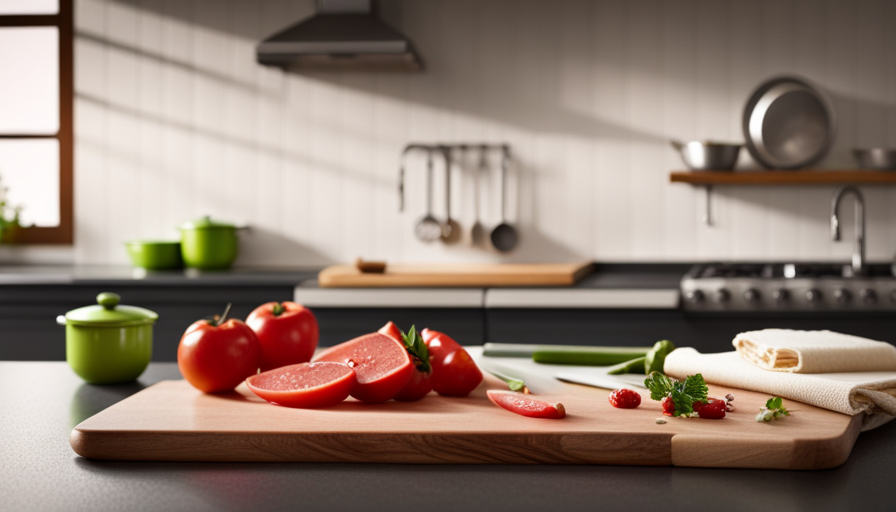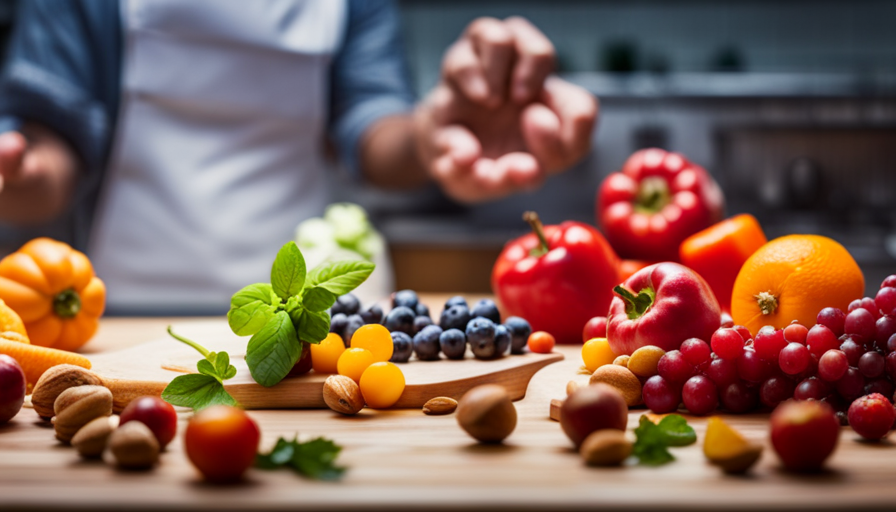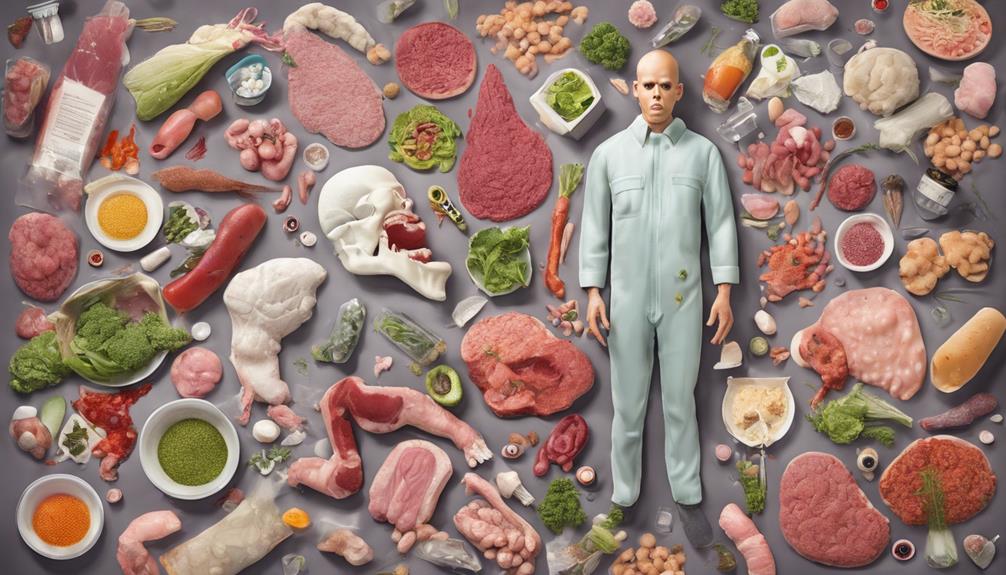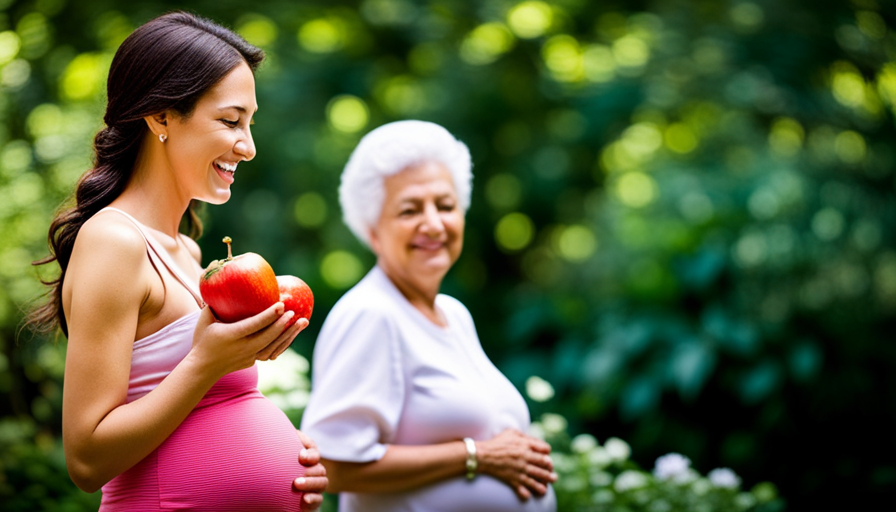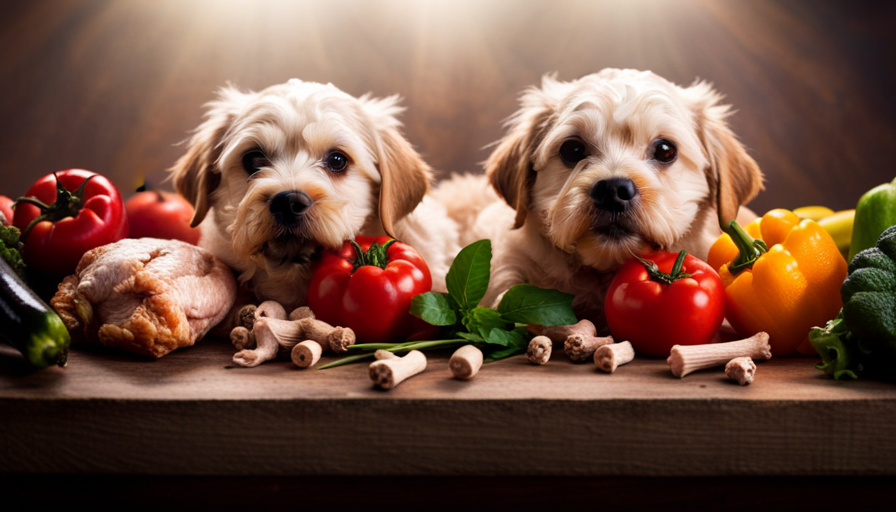Imagine this scenario: you are throwing a dinner party, and you have spent a lot of time preparing a delicious spread for your guests. As you present the dishes you have cooked with pride, you feel a sense of achievement. However, what if I were to inform you that there is a hidden threat in your kitchen that has the potential to spoil your flawless meal?
Cross-contamination from raw food to cooked or ready-to-eat food is a serious risk that can lead to foodborne illnesses. Every year, millions of people suffer from food poisoning, with cross-contamination being one of the main culprits. But fear not, for there are proactive steps you can take to prevent this from happening.
In this article, I will guide you through a comprehensive plan to ensure that your food remains safe and uncontaminated. From understanding the risks of cross-contamination to implementing proper food handling practices, practicing good personal hygiene, and maintaining a clean and sanitized kitchen, we will leave no stone unturned.
So, let’s dive in and learn how to protect ourselves and our loved ones from the dangers of cross-contamination.
Key Takeaways
- Use separate cutting boards and utensils for raw and cooked foods to prevent cross-contamination.
- Practice proper handwashing techniques, including washing hands with soap and warm water for at least 20 seconds.
- Store raw meats in leak-proof containers on lower refrigerator shelves to prevent any drips or spills from contaminating other foods.
- Regularly clean and sanitize countertops, utensils, and equipment to eliminate harmful pathogens and reduce the risk of cross-contamination.
Understand the Risks of Cross-Contamination
Cross-contamination poses serious risks in the kitchen, and it’s crucial to understand how it can occur to protect the safety of our cooked and ready-to-eat food. When raw food comes into contact with cooked or ready-to-eat food, harmful bacteria can be transferred, leading to foodborne illnesses. This is why it’s essential to prevent cross-contamination.
There are several risks associated with cross-contamination. One risk is the transfer of bacteria from raw meat, poultry, or seafood to other foods, such as fruits, vegetables, or bread. Another risk is the use of the same cutting board or knife for raw and cooked foods, which can spread bacteria from one to the other. Additionally, improper handwashing can also contribute to cross-contamination.
To prevent cross-contamination, it’s important to implement proper food handling practices. This includes using separate cutting boards and utensils for raw and cooked foods. It’s also crucial to wash hands thoroughly with soap and warm water before and after handling raw food. Additionally, storing raw meats in leak-proof containers on the lower shelves of the refrigerator can help prevent any drips or spills from contaminating other foods.
By understanding the risks of cross-contamination and implementing proper prevention methods, we can ensure the safety of our cooked and ready-to-eat food. It’s important to be proactive in the kitchen and take the necessary precautions to protect ourselves and our loved ones from foodborne illnesses.
Implement Proper Food Handling Practices
To ensure safe handling, you should implement proper practices when preparing and serving your meals. One important aspect of proper food handling is practicing proper handwashing techniques. Before and after handling raw food, it is crucial to wash your hands thoroughly with soap and warm water for at least 20 seconds. This helps to eliminate any potential bacteria or pathogens that can cause cross-contamination.
Another way to prevent cross-contamination is by ensuring proper food storage. Keep raw meat, poultry, and seafood separate from ready-to-eat foods such as fruits, vegetables, and cooked dishes. This can be achieved by using separate cutting boards, utensils, and storage containers. Additionally, it is essential to clean and sanitize all surfaces, utensils, and equipment after each use to eliminate any potential bacteria.
To make it easier to understand and apply these practices, let’s take a look at a helpful table:
| Proper Handwashing Techniques | Preventing Cross Contamination in Food Storage Areas |
|---|---|
| Wash hands with soap and warm water for at least 20 seconds | Keep raw and ready-to-eat foods separate |
| Scrub hands thoroughly, including between fingers and under nails | Store raw meats, poultry, and seafood in separate containers |
| Rinse hands well under clean, running water | Use separate cutting boards and utensils for raw and ready-to-eat foods |
| Dry hands with a clean towel or air dryer | Clean and sanitize all surfaces, utensils, and equipment after use |
By following these proper practices, you can effectively prevent cross-contamination and ensure the safety of your meals. Practice good personal hygiene by incorporating these habits into your daily routine.
Practice Good Personal Hygiene
Maintaining good personal hygiene is essential in ensuring the safety and cleanliness of your meals. Proper handwashing is one of the most important practices to prevent cross-contamination from raw food to cooked or ready-to-eat food. Before handling any food, it’s crucial to wash your hands with warm water and soap for at least 20 seconds. This should be done before and after handling raw food, using the restroom, coughing or sneezing, or touching any surfaces that may be contaminated.
In addition to handwashing, wearing gloves can provide an extra layer of protection. Gloves should be worn when handling ready-to-eat food or when there are cuts or sores on the hands. However, it’s important to remember that gloves aren’t a substitute for handwashing. Hands should still be washed before putting on gloves and after removing them.
By practicing good personal hygiene, such as proper handwashing and wearing gloves when necessary, we can significantly reduce the risk of cross-contamination. These simple steps demonstrate our commitment to food safety and the well-being of our customers.
Transitioning into the subsequent section about maintaining a clean and sanitized kitchen, it’s equally important to extend our hygiene practices beyond ourselves.
Maintain a Clean and Sanitized Kitchen
To maintain a clean and sanitized kitchen, I make it a priority to regularly clean countertops, utensils, and equipment. I scrub away any food residue and use disinfectant to ensure surfaces are free from bacteria.
Additionally, I use sanitizing solutions to wipe down all surfaces, including cutting boards and knives, to eliminate any harmful pathogens.
Lastly, I take proactive measures to prevent pests and rodents by sealing any cracks or openings, storing food properly, and regularly inspecting the kitchen for signs of infestation.
By following these steps, I ensure a safe and hygienic environment for food preparation.
Regularly clean countertops, utensils, and equipment
Clean countertops, utensils, and equipment regularly to rid the kitchen of potential cross-contamination. To ensure a safe and hygienic environment, I employ effective cleaning techniques and sanitizing methods. Here’s how I tackle this crucial task:
- First, I meticulously wipe down countertops using a solution of warm water and dish soap, removing any visible debris or spills that could harbor harmful bacteria.
- Next, I diligently scrub utensils with hot, soapy water, paying special attention to hard-to-reach areas where food particles can accumulate.
Lastly, I thoroughly clean and sanitize equipment, such as cutting boards and food processors, using a bleach solution or a sanitizing spray recommended for kitchen use.
By regularly cleaning and sanitizing countertops, utensils, and equipment, I ensure the prevention of cross-contamination in the kitchen. Moving forward, let’s delve into the next section where we discuss the importance of using sanitizing solutions.
Use sanitizing solutions
By using the power of sanitizing solutions, you can create a shield of protection against invisible threats lurking in your kitchen. Sanitizing solutions are highly effective in eliminating harmful bacteria and preventing cross-contamination from raw food to cooked or ready-to-eat food.
To ensure the proper usage of sanitizing solutions, it’s crucial to follow the instructions provided by the manufacturer. This includes using the correct concentration and contact time to maximize their effectiveness.
For countertops, utensils, and equipment, a sanitizing solution can be prepared by mixing a teaspoon of bleach with a gallon of water. This solution should be applied to the surfaces and left to air dry.
Regularly using sanitizing solutions will significantly reduce the risk of contamination and maintain a safe environment in your kitchen.
Moving forward to prevent pests and rodents, it’s essential to implement additional measures.
Prevent pests and rodents
Keep pests and rodents at bay in your kitchen by implementing effective prevention measures. Proper pest control is essential to prevent cross-contamination from raw food to cooked or ready-to-eat food. One of the key aspects of pest control is proper waste management. Make sure to dispose of food waste in sealed containers and regularly empty the trash to avoid attracting pests. Additionally, keep your kitchen clean and free of crumbs or spills that can attract pests. Implementing physical barriers, such as screens on windows and doors, can also help prevent pests from entering the kitchen. By taking these proactive steps, you can minimize the risk of pests and rodents contaminating your food. Now, let’s move on to the next section about how to store food properly.
Store Food Properly
When it comes to storing food properly in my kitchen, I make sure to maintain the right temperatures to prevent spoilage and bacterial growth. I always use airtight containers to keep my food fresh and protected from contaminants.
Additionally, I follow the first-in, first-out (FIFO) method to ensure that older items are used first, minimizing the risk of food waste.
By being proactive in my storage practices, I can maintain the quality and safety of the food in my kitchen.
Maintain proper storage temperatures
To ensure the safety of your meals, it’s crucial to store raw food and cooked or ready-to-eat food at the appropriate temperatures.
Proper refrigeration is essential in preventing cross-contamination. Raw foods, such as meats and poultry, should be stored in the refrigerator at a temperature of 40°F (4°C) or below. Cooked or ready-to-eat foods, on the other hand, should be kept at a temperature of 41°F (5°C) or above.
It’s important to regularly monitor the temperature of your refrigerator to ensure it remains within these ranges. This can be done using a refrigerator thermometer.
By maintaining proper storage temperatures, you can minimize the risk of harmful bacteria multiplying and spreading from raw food to cooked or ready-to-eat food.
To further prevent cross-contamination, it’s also recommended to use airtight containers for storage, which I will discuss in the subsequent section.
Use airtight containers
Using airtight containers is like sealing in the freshness and flavor of your meals. These containers provide numerous benefits when it comes to preventing cross-contamination from raw food to cooked or ready-to-eat food.
Firstly, airtight containers create a barrier that prevents any bacteria or pathogens from entering the food. This helps ensure that your meals are safe to consume. Additionally, these containers help to maintain the integrity of the food by keeping it at a consistent temperature, which further reduces the risk of contamination.
Moreover, airtight containers also prevent any odors from spreading and mixing with other foods, preserving the taste and quality. As an alternative to airtight containers, you could use ziplock bags or vacuum-sealed bags, although they may not provide the same level of protection.
Transitioning to the subsequent section, it’s important to follow the first-in, first-out (FIFO) method to further prevent cross-contamination.
Follow first-in, first-out (FIFO) method
Make sure you always follow the first-in, first-out (FIFO) method to keep your meals fresh and safe. FIFO implementation is a crucial step in preventing cross-contamination from raw food to cooked or ready-to-eat food. By following this method, you ensure that the oldest products are used first, reducing the risk of spoilage and contamination.
This method involves organizing your food items according to their expiration dates or use-by dates. Place the items with the closest expiration dates in front, making them easily accessible and visible. By doing so, you can prioritize their use and avoid any potential cross-contamination issues.
This proactive approach not only helps maintain the quality and freshness of your food but also minimizes the risk of foodborne illnesses. Educating staff and training them on food safety is the next important step in ensuring a safe and hygienic food environment.
Educate Staff and Train Them on Food Safety
Ensure your staff is well-informed and properly trained on food safety practices to protect your customers and maintain the highest standards of cleanliness and hygiene. Staff training and food safety education are crucial in preventing cross-contamination from raw food to cooked or ready-to-eat food. By equipping your staff with the necessary knowledge and skills, you can minimize the risk of foodborne illnesses and ensure the safety of your customers.
To effectively educate your staff on food safety, consider implementing a comprehensive training program. This program should cover topics such as proper handling and storage of raw food, importance of hand hygiene, and cleaning and sanitizing procedures. By providing regular training sessions, you can reinforce these practices and keep your staff up-to-date with the latest food safety regulations.
One effective way to engage your staff during training is by using visual aids. Consider incorporating a table that highlights the key principles of food safety. Here’s an example:
| Food Safety Principle | Description | Importance |
|---|---|---|
| Proper Hand Hygiene | Thoroughly washing hands to prevent contamination | Essential for preventing the spread of harmful bacteria |
| Safe Food Storage | Storing food at appropriate temperatures | Prevents bacterial growth and maintains food quality |
| Cross-Contamination | Avoiding contact between raw and cooked food | Prevents the transfer of pathogens from raw food to cooked |
By using visual aids like this table, you can effectively communicate key food safety principles to your staff, making the training sessions more engaging and memorable.
Staff training and food safety education play a vital role in preventing cross-contamination. By ensuring your staff is well-informed and trained, you can minimize the risk of foodborne illnesses and protect the health of your customers. Up next, we will discuss how to monitor and control temperature to further enhance food safety practices.
Monitor and Control Temperature
To ensure food safety, I’ll implement a rigorous temperature monitoring system. This will involve using thermometers to regularly check the temperatures of our food items, both during storage and preparation.
Additionally, I’ll emphasize the importance of properly thawing frozen foods to prevent any potential temperature abuse.
By being diligent in these practices, we can actively prevent any risks of foodborne illnesses and maintain the highest standards of food safety.
Use thermometers to check food temperatures
Using food grade thermometers to check food temperatures is an effective way to prevent cross-contamination from raw food to cooked or ready-to-eat food. By implementing temperature monitoring, we can ensure that food is being cooked to the proper internal temperature, killing any harmful bacteria that may be present.
Food grade thermometers are specifically designed to accurately measure the temperature of food, providing us with reliable readings. Regularly checking the temperature of food during cooking and holding periods allows us to identify any potential issues and take corrective actions immediately. This proactive approach helps us maintain the safety and quality of our food.
As we move into the next section about properly thawing frozen foods, it’s important to continue following proper temperature control practices to prevent cross-contamination.
Properly thaw frozen foods
When thawing frozen foods, you’ll want to make sure you defrost them properly to maintain their quality and taste. To prevent cross-contamination and ensure food safety, here are some safe thawing techniques to follow:
-
Thaw in the refrigerator: Place the frozen food on a plate or in a container, and allow it to thaw slowly in the refrigerator. This method prevents the growth of harmful bacteria.
-
Use cold water: If you’re in a hurry, you can thaw the food by placing it in a leak-proof plastic bag and submerging it in cold water. Change the water every 30 minutes to maintain a safe temperature.
-
Use the microwave: Use the defrost setting on your microwave to thaw small portions of food quickly. Be sure to cook the food immediately after thawing.
-
Cook from frozen: Some foods, like vegetables and seafood, can be cooked directly from frozen, eliminating the need for thawing.
By following these safe thawing techniques, you can prevent cross-contamination and ensure the safety of your cooked or ready-to-eat food.
Now, let’s move on to the next section about avoiding temperature abuse.
Avoid temperature abuse
Now that we understand the importance of properly thawing frozen foods, let’s shift our focus to another crucial aspect of preventing cross-contamination: avoiding temperature abuse.
Temperature monitoring plays a vital role in safe food handling. It is essential to keep a close eye on the temperatures of both raw and cooked or ready-to-eat foods. This can be done by regularly checking the temperature of refrigerators and freezers, as well as using thermometers to ensure that cooked foods are kept at safe temperatures.
Additionally, it is crucial to promptly refrigerate or freeze perishable foods to prevent them from sitting at room temperature for too long. By diligently monitoring temperatures and practicing safe food handling techniques, we can significantly reduce the risk of cross-contamination.
Now, let’s explore the next section, which focuses on implementing the Hazard Analysis and Critical Control Points (HACCP) system.
Implement Hazard Analysis and Critical Control Points (HACCP) System
To effectively prevent cross-contamination, it’s crucial to implement the Hazard Analysis and Critical Control Points (HACCP) system. HACCP analysis allows us to identify potential hazards and establish control measures to prevent them from occurring.
By implementing this system, we can ensure that all steps of the food preparation process are monitored and controlled to minimize the risk of cross-contamination.
One key aspect of HACCP implementation is the identification of critical control points. These are specific points in the process where control measures can be applied to prevent, eliminate, or reduce hazards to an acceptable level. By identifying these points, we can focus our efforts on implementing effective control measures to prevent cross-contamination.
Another important aspect of HACCP is the establishment of monitoring procedures. These procedures allow us to regularly check that control measures are being followed correctly and that cross-contamination risks are being effectively managed. By conducting frequent monitoring, we can quickly identify any deviations from the established control measures and take corrective actions to prevent cross-contamination.
Moreover, HACCP emphasizes the importance of record-keeping. By maintaining detailed records of our monitoring activities and corrective actions taken, we can demonstrate our commitment to food safety and ensure accountability. These records also serve as a valuable resource for conducting regular inspections and audits to verify the effectiveness of our control measures.
Implementing the HACCP system is essential for preventing cross-contamination in food preparation. By identifying critical control points, implementing monitoring procedures, and maintaining detailed records, we can effectively manage cross-contamination risks. This systematic approach provides us with the necessary tools to conduct regular inspections and audits, ensuring the ongoing effectiveness of our control measures in preventing cross-contamination.
Conduct Regular Inspections and Audits
Regular inspections and audits ensure that I am consistently maintaining high standards of food safety and minimizing potential risks. By conducting regular inspections, I am able to identify any issues or areas of concern that may arise in my kitchen. This allows me to take immediate action to address and rectify these issues before they become a larger problem.
During these inspections, I focus on various aspects of food safety, such as proper storage of raw and cooked foods, cleaning and sanitizing procedures, and the overall cleanliness of the kitchen environment. I also pay close attention to the personal hygiene practices of my staff, ensuring that they are following proper handwashing techniques and wearing appropriate protective gear.
In order to effectively conduct these inspections, I have implemented a food safety training program for all of my staff members. This ensures that they are knowledgeable about the necessary protocols and procedures to maintain a safe and hygienic kitchen environment.
By regularly conducting inspections and providing ongoing food safety training, I am able to stay informed and updated on the latest food safety guidelines. This allows me to continuously improve and adapt my practices to ensure the highest level of food safety for my customers.
Stay Informed and Updated on Food Safety Guidelines
Make sure you stay informed and updated on food safety guidelines to ensure the highest level of safety and cleanliness in your kitchen. Being knowledgeable about food safety is crucial in preventing foodborne illnesses and maintaining proper food handling practices.
By staying informed, you can proactively implement preventive measures to prevent cross-contamination from raw food to cooked or ready-to-eat food.
One of the key aspects of staying informed is understanding the importance of proper food handling. This includes knowing the correct temperatures for cooking, storing, and reheating different types of food. By following these guidelines, you can minimize the risk of bacteria growth and cross-contamination.
Regularly checking for updates on food safety guidelines is also essential. These guidelines are constantly evolving as new research and information become available. By staying updated, you can learn about new techniques and best practices that can further enhance the safety and cleanliness of your kitchen.
Additionally, attending training sessions or workshops on food safety can provide you with valuable insights and practical knowledge. These sessions often cover topics such as proper handwashing techniques, safe storage practices, and effective cleaning and sanitizing methods. By actively seeking out these opportunities, you can continually improve your understanding of food safety and implement the latest recommendations in your kitchen.
Staying informed and updated on food safety guidelines is vital for preventing cross-contamination and ensuring the highest level of safety and cleanliness in your kitchen. By being detail-oriented, knowledgeable, and proactive, you can effectively protect yourself and others from foodborne illnesses.
Frequently Asked Questions
What are the common sources of cross-contamination in a kitchen?
Improper handling of raw meat, poultry, and seafood, as well as using the same cutting board or utensils for raw and cooked food, are common sources of cross-contamination in a kitchen. This can lead to the transfer of harmful bacteria and pathogens from raw food to ready-to-eat food.
To prevent this, it’s crucial to practice proper food handling and sanitation techniques. This includes using separate cutting boards and utensils for raw and cooked foods, and regularly cleaning and sanitizing all surfaces and equipment.
How often should kitchen utensils and equipment be cleaned and sanitized to prevent cross-contamination?
To prevent cross-contamination, it’s crucial to regularly clean and sanitize kitchen utensils and equipment. Proper cleaning and sanitizing of these items play a vital role in maintaining food safety. The frequency of cleaning and sanitizing depends on the level of usage and the type of food being prepared.
As a rule of thumb, kitchen utensils and equipment should be cleaned and sanitized after each use, especially when transitioning from handling raw food to cooked or ready-to-eat food.
Are there any specific food items that are more prone to cross-contamination than others?
Prone food items that are more susceptible to cross-contamination include raw meat, poultry, seafood, and eggs. To prevent this, I ensure proper storage by keeping raw food separate from ready-to-eat items.
I also use separate cutting boards and utensils for raw and cooked foods, and sanitize them regularly. Additionally, I practice good hand hygiene and avoid touching ready-to-eat food with bare hands.
These prevention measures help maintain food safety and minimize the risk of cross-contamination.
What measures can be taken to prevent cross-contamination during food delivery or transportation?
To prevent cross-contamination during food delivery or transportation, I ensure proper packaging and separation of raw and cooked/ready to eat food. This includes using separate containers and packaging materials to prevent contact between the two.
Additionally, I prioritize regular cleaning and sanitizing of food delivery vehicles to eliminate any potential sources of contamination.
By implementing these measures, I can confidently deliver safe and hygienic food to customers, minimizing the risk of cross-contamination.
How can cross-contamination be prevented in self-service buffet or salad bar settings?
In the world of self-service buffets and salad bars, preventing cross-contamination is like building a fortress around a treasure. To ensure utmost safety, I employ various strategies.
Firstly, clear signage and instructions guide customers on proper utensil handling, preventing any unwanted mix-ups.
Secondly, I diligently monitor and replenish food items, avoiding any mingling of fresh and old ingredients.
With my attention to detail and proactive approach, I keep cross-contamination at bay, safeguarding the delectable delights for everyone to enjoy.
How Can Cross-Contamination from Raw Food be Prevented when Handling Ready-to-Eat Food?
When handling ready-to-eat food, preventing cross-contamination from raw food is essential for food safety. To minimize the risk, always use separate cutting boards and utensils for raw and ready-to-eat foods. Additionally, practice proper handwashing and sanitizing surfaces to avoid any potential hazards. Following these protocols ensures the raw food cooking benefits while maintaining food safety.
Conclusion
To sum it up, preventing cross-contamination from raw food to cooked or ready-to-eat food requires a proactive approach and attention to detail. By understanding the risks and implementing proper food handling practices, practicing good personal hygiene, and maintaining a clean and sanitized kitchen, we can minimize the chances of contamination.
Storing food properly, monitoring temperature, and implementing a HACCP system further ensures food safety. Regular inspections and staying informed on food safety guidelines are essential.
Remember, in the world of food safety, prevention is better than cure – like a well-seasoned dish, it’s always better to be proactive and take measures to keep our food safe.

